by admin ~ March 15th, 2007
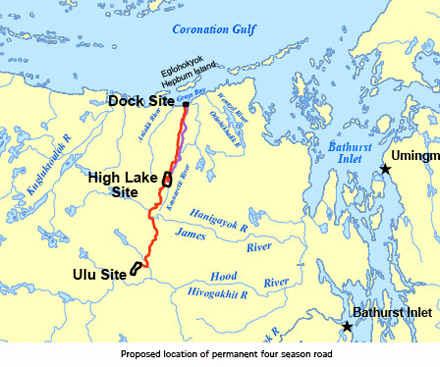
One of several proposed roads for the Kitikmeot Region of Nunavut, the junior mining company from Thunder Bay, Wolfden Resources Inc., received a favorable review for its copper/zinc mine proposal from the Nunavut Impct Review Board (NIRB). The 53 km all weather road will include a dock facility at Grays Bay on the Coronation Gulf, and will parallel the Kennartic River to the mine site at High Lake. Wolfden also owns the proposed Ulu gold mine 55 km south of the proposed High Lake road in the headwaters of the Hood River.
Next steps include public hearings and formal Environmental Assessment process, which could last up to two years. The Director of Technical Services for the NIRB stated: “There was concerns over wildlife and eco-systemic impacts that may be significant and adverse.” He also stated public interest in the project is high (1). Mine proposal includes open pit and underground methods, construction of permanent all-season road, airstrip, dock facilities, winter-trail routes, on-site facilities for processing ore, and off-site processing for gold. “Tailings will be deposited into an impoundment and covered with water to inhabit oxidation and prevent acid generation and metal leaching. To ensure that the tailings remain under water, four dams will be constructed along the lake’s perimeter, which will also prevent uncontrolled release into the Kennarctic River.” Wolfden received an influx of investment capital from Goldcorp last November, and has sought access agreements for Inuit owned lands and has promised employment for qualified Inuit workers. Mine life is projected at 14 years.
Sources:
Filed under: Lands and Resources, Mining
Comments Off on Proposal for Road and Mine Project at High Lake Gets Approval from Nunavut Impact Review Board
by admin ~ March 14th, 2007
Alaska Public Radio has provided an audio remembrance of anthropologist and author Lydia T. Black, who passed away in her home in Kodiak, Alaska, on Monday, March 12, 2007. The broadcast details stories from family and colleagues, and her passionate commitment to teaching and Alaska Native culture and history. You can hear the radio broadcast at the APRN web site, or enclosed audio file. Born on December 16, 1925, she was 81 years old.
[audio:http://northernwaterways.com/blog/audio/black.mp3]
Filed under: Alaska, Anthropology
1 Comment »
by admin ~ March 14th, 2007
 Cape Dorset artist Annie Pootoogook is the subject of a 30 minute documentary by Marcia Connolly to appear on Bravo! (April 1 at 8:30pm ET / 5:30pm PT). Her work has drawn a great deal of attention in the last several years, after being featured in an exhibit by the Power Plant Contemporary Art Gallery in Toronto, and winning the Sobey Art Award in 2006. She has three generations of artists in her family, each with a distinguished career promoting new media, and their own individual narrative perspective on Inuit life and culture. Her work has the distinct power of taking the mundane, and making it into an icon of cultural or individual struggles and drawing viewers into the unresolved tensions of contemporary Inuit life and realities. She says of her work: “I see and I do – I’m very happy that I can put down on paper what I’m feeling inside or what I have in my head. I cannot draw anything that I myself did not experience.” Noted Canadian filmmaker Atom Egoyan says of the film: “Marcia Connolly has created an extraordinary documentary – Her camera has found a beautiful way of implicating itself into Pootoogook’s community in Cape Dorset, creating an intimacy and sense of spiritual kinship which is profoundly touching and rare. This is one of the finest portraits of an artist I have ever seen.” For further information, you can view the site(media)inc. preview of the documentary and news sources listed below, or the CBC photo essay on her recent work.
Cape Dorset artist Annie Pootoogook is the subject of a 30 minute documentary by Marcia Connolly to appear on Bravo! (April 1 at 8:30pm ET / 5:30pm PT). Her work has drawn a great deal of attention in the last several years, after being featured in an exhibit by the Power Plant Contemporary Art Gallery in Toronto, and winning the Sobey Art Award in 2006. She has three generations of artists in her family, each with a distinguished career promoting new media, and their own individual narrative perspective on Inuit life and culture. Her work has the distinct power of taking the mundane, and making it into an icon of cultural or individual struggles and drawing viewers into the unresolved tensions of contemporary Inuit life and realities. She says of her work: “I see and I do – I’m very happy that I can put down on paper what I’m feeling inside or what I have in my head. I cannot draw anything that I myself did not experience.” Noted Canadian filmmaker Atom Egoyan says of the film: “Marcia Connolly has created an extraordinary documentary – Her camera has found a beautiful way of implicating itself into Pootoogook’s community in Cape Dorset, creating an intimacy and sense of spiritual kinship which is profoundly touching and rare. This is one of the finest portraits of an artist I have ever seen.” For further information, you can view the site(media)inc. preview of the documentary and news sources listed below, or the CBC photo essay on her recent work.

Sources:
Filed under: Film and Video, First Nations, Graphic Arts, Life and Culture
Comments Off on Profile of Inuit artist Annie Pootoogook to debut on Canadian Arts Network
by admin ~ March 13th, 2007
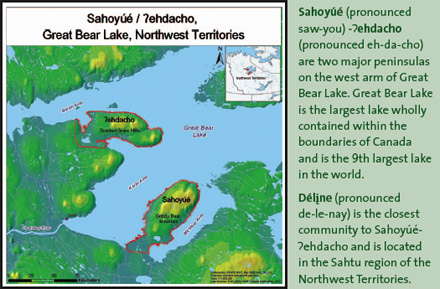
The Sahtugot’ine of Deline get funding and support from Parks Canada to protect lands and harvesting rights on two peninsulas in Great Bear Lake: Scented Grassy Hills and Grizzly Bear Mountain. The community of Deline has worked for 20 years to protect these lands from surface and subsurface mineral rights, and have formally proposed that the lands be set aside for all Canadians and visitors as a National Historic Site under the Northwest Territories Protected Areas Strategy.
 The new agreement provides $10 million in funding for initial development of the National Historical Site and operations for the next five years, and was signed between Parks Canada, the Deline First Nation, and the Deline Land Corporation. Long used as an important gathering place and traditional harvesting area, the Sahtugot’ine of Deline continue to make a livelihood from the Sahoyúé and ehdacho regions of Great Bear Lake, and seek protection of the site for traditional uses, ecological values, and to commemorate Dene place names, traditional knowledge, and oral histories in the area. “This national historic site will be managed in a way that enables the Sahtugot’ine to continue their traditional uses of the land and provides opportunities for Canadians to experience and appreciate the land and its heritage values” (1). The new Historic Site reflects the shared vision of government and First Nations for the future of the NWT, and the importance of recent agreements such as the Northwest Territories Protected Areas Strategy and the Sahtu Dene and Metis Comprehensive Land Claim Agreement of 1993.
The new agreement provides $10 million in funding for initial development of the National Historical Site and operations for the next five years, and was signed between Parks Canada, the Deline First Nation, and the Deline Land Corporation. Long used as an important gathering place and traditional harvesting area, the Sahtugot’ine of Deline continue to make a livelihood from the Sahoyúé and ehdacho regions of Great Bear Lake, and seek protection of the site for traditional uses, ecological values, and to commemorate Dene place names, traditional knowledge, and oral histories in the area. “This national historic site will be managed in a way that enables the Sahtugot’ine to continue their traditional uses of the land and provides opportunities for Canadians to experience and appreciate the land and its heritage values” (1). The new Historic Site reflects the shared vision of government and First Nations for the future of the NWT, and the importance of recent agreements such as the Northwest Territories Protected Areas Strategy and the Sahtu Dene and Metis Comprehensive Land Claim Agreement of 1993.
Sources:
Filed under: First Nations, Life and Culture, Parks
Comments Off on New Agreement for Proposed National Historic Site on the Great Bear Lake in the Northwest Territories, Canada
by admin ~ March 13th, 2007
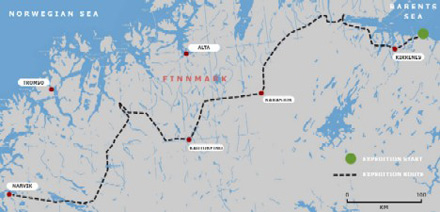
Seven member team begins its sled-dog trek across arctic Finnmark to document Sámi heritage, environmental effects of global warming, and snow conditions for the Global Snowflake Network of NASA. The expedition will cover 1,500 km in one month, and visit the birch and pine forests of the Russian Taiga, the Sámi settlement of Neiden, the great Tana river between Finland and Norway, the northern tundra and heart of Sámiland around Kautokeino, and the northern coast of Sweden with its mountainous territory. “Field research will concentrate on shifts in herds’ migration routes to spring calving grounds, and consequently on traditional year-round economic practices, in order to focus, more broadly, on reindeer herding knowledge in a changing climate” (1). Expedition hopes to bring attention to the renewable resource heritage of Sámi reindeer herding, and the effects of climate change in this vulnerable region. Expedition diary includes daily updates, and website has additional information on Sámi Culture and environmental effects of climate change. You can also follow a similar expedition in northern Canada, Baffin Island 2007, involving educators, scientists, dog mushing enthusiasts, and Inuit hunters.
Filed under: Climate Change, Expeditions, Film and Video, First Nations, Life and Culture, Mining, Parks
Comments Off on Northern Sámi and Climate Change Focus of 2007 Finnmark Sled-Dog Expedition
by admin ~ March 8th, 2007
 For two years in a row, NWT author Jamie Bastedo has traveled the Mackenzie and Slave Rivers for the NWT Recreation and Parks Association to document this historic river route and to provide a guide to the NWT portion of the Trans Canada Trail. Intended as more than a set of maps and river notes, the guide will explore the unique natural and cultural heritage of the Trail, and his experiences along the way. “There are hundreds of voices in the book,” Bastedo said. “The people along the route give it its spirit” (1). From Fort Smith to Whitefish station (an Inuvialuit whaling camp on the shores of the Beaufort Sea), Bastedo chronicles his many experiences in Deh Cho fishing camps, visiting historic landmarks, river communities, and more. He hopes his guide will provide a sense of the “living fabric” of the river for the many people who live along this portion of the Trans Canada Trail.
For two years in a row, NWT author Jamie Bastedo has traveled the Mackenzie and Slave Rivers for the NWT Recreation and Parks Association to document this historic river route and to provide a guide to the NWT portion of the Trans Canada Trail. Intended as more than a set of maps and river notes, the guide will explore the unique natural and cultural heritage of the Trail, and his experiences along the way. “There are hundreds of voices in the book,” Bastedo said. “The people along the route give it its spirit” (1). From Fort Smith to Whitefish station (an Inuvialuit whaling camp on the shores of the Beaufort Sea), Bastedo chronicles his many experiences in Deh Cho fishing camps, visiting historic landmarks, river communities, and more. He hopes his guide will provide a sense of the “living fabric” of the river for the many people who live along this portion of the Trans Canada Trail.
 Jamie Bastedo is the author of numerous books on northern history, culture, and lands. In 2002, he won the Michael Smith Award for his contributions to science and his work as an educator, performer, and environmental consultant. His book Shield Country is an accessible reference book that tells the story of the geological scope and history of this largest landmass in Canada. He is a former host of CBC North, and currently resides in Yellownife, NWT. His trail guide is set to be released later in the year.
Jamie Bastedo is the author of numerous books on northern history, culture, and lands. In 2002, he won the Michael Smith Award for his contributions to science and his work as an educator, performer, and environmental consultant. His book Shield Country is an accessible reference book that tells the story of the geological scope and history of this largest landmass in Canada. He is a former host of CBC North, and currently resides in Yellownife, NWT. His trail guide is set to be released later in the year.
Sources:
Filed under: Books, Canoeing, Life and Culture, Parks
Comments Off on Jamie Bastedo on the Mackenzie River and Trans Canada Trail
by admin ~ March 6th, 2007
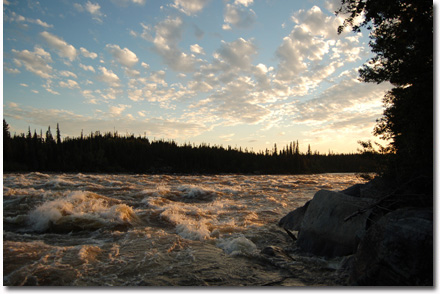
Flickr is once again home to a stunning set of photographs on the Rupert River in northern Quebec. Created by Cree photographer Ian Diamond from Waskaganish, his photo collection currently runs over 1000 images, and grows weekly with winter scenes from his home and the spectacular Rupert River. His community was in the news recently when plans were finalized this January for a Hydro Quebec diversion project on the Rupert. He states he is “trying to capture as many photos as he can,” and he continues to provide an invaluable documentary record for this historic watershed near his home and in the lands of the James Bay Cree. Please take time to view his Rupert River Photo Set on Flickr (1418 photos and counting), and subscribe to his photo blog for updates to his site. He has many photography fans on the web, and I continue to be astounded by his images and documentary record.
All photos are copyrighted by Ian Diamond, and are reproduced here with the photographer’s permission.
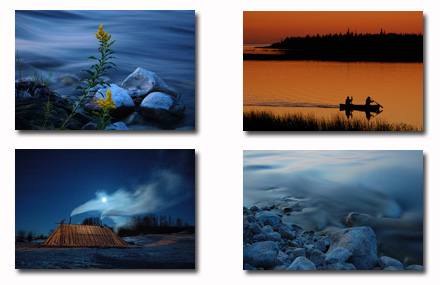
Additional Sites:
Filed under: Featured Web Media, First Nations, Photography, Rupert River
Comments Off on Featured Photo Blog: Rupert River and Waskaganish in James Bay, Canada
by admin ~ March 5th, 2007

Located 90 km downstream of Gillam on the Nelson River in northern Manitoba, the proposed Conawapa Generating Station aims to be the largest hydroelectric project in Manitoba. The area has already seen the impact of 40 years of hydro development, and outstanding community and environmental concerns at the Fox Lake Cree Nation were finally addressed in a settlement agreement in 2004. The current agreement signed last week proposes to provide funding to Fox Lake, and facilitate their involvement in planning and consultation in project plans, “environmental and regulatory matters, training, employment and business opportunities, and the negotiation of adverse effects arrangements” (1). Elders in the community advise that negotiators remain cautious, and balance economic benefits, community concerns, and previous experience of the Fox Lake Cree Nation (and other First Nations) with Manitoba Hydro. In their press release, Manitobo Hydro recognizes the need for a new and positive relationship, and their commitment to “work together in a new and structured way to cooperatively address issues of mutual interest and concern within the Gillam area.” Agreements have also been reached with the York Factory First Nation, and are proposed for the Tataskweyak Cree Nation and War Lake First Nation.
Sources:
Filed under: First Nations, Hydroelectric, Lands and Resources, Life and Culture
1 Comment »
by admin ~ March 5th, 2007
 An event that draws canoe and paddle enthusiasts from across the country is set to begin this Friday in Madison, Wisconsin. Hosted by Rutabega Paddlesports, the outdoors expo includes an extensive exhibitor list of popular manufacturers of paddle gear and boats, and a full weekend of speakers. Some topics include James Raffan on the Life of Bill Mason, Justine Curgenven on her award winning film “This is the Sea 3,” presentations on the Northern Forest Canoe Trail and Waterkeeper Alliance, and numerous other speakers on filmmaking, wilderness trips, boat making, repair, safety, paddle skills, wilderness cooking, photography, and more. The Canoecopia Website has more, including directions and the full speaker schedule. I’ll be there the whole weekend, and I hope to see you there as well.
An event that draws canoe and paddle enthusiasts from across the country is set to begin this Friday in Madison, Wisconsin. Hosted by Rutabega Paddlesports, the outdoors expo includes an extensive exhibitor list of popular manufacturers of paddle gear and boats, and a full weekend of speakers. Some topics include James Raffan on the Life of Bill Mason, Justine Curgenven on her award winning film “This is the Sea 3,” presentations on the Northern Forest Canoe Trail and Waterkeeper Alliance, and numerous other speakers on filmmaking, wilderness trips, boat making, repair, safety, paddle skills, wilderness cooking, photography, and more. The Canoecopia Website has more, including directions and the full speaker schedule. I’ll be there the whole weekend, and I hope to see you there as well.
Filed under: Canoeing, Events
Comments Off on Canoecopia 2007 (March 9-11)
by admin ~ February 28th, 2007

North Shore native whaling communities in Alaska are troubled over oil and gas exploration proposals in Beaufort Sea. “The U.S. Minerals Management Service has approved Shell’s plan to drill as many as a dozen exploration wells over the next two years in the Beaufort Sea” (1). Approval does not call for an environmental impact review, and Alaska native and conservation groups oppose proposal without further input and discussion of the impact of seismic activity on bowhead whale populations. An Alaska Public Radio report on the issue can be heard below:
Updates:
- New York Times: “In Alaska’s Far North, Two Cultures Collide” (Dec. 04, 2007), “Of Humans, Oil, and Whales” (Dec. 17, 2007), “Court Says Shell Can’t Drill Near Alaska” (Nov. 20, 2008).
- Web Media Presentation: “A Dilemma in the Arctic” (NYT).
- Associated Press: “Court orders review of Beaufort drilling plan” (Nov. 21, 2008).
- Associated Press: “Court Cancels Offshore Drilling Plan” (April 17, 2009).
- New York Times: “Shell to Shift Alaska Exploration Plans” (May 06, 2009).
[audio:http://stream.publicbroadcasting.net/production/mp3/apti/local-apti-567999.mp3]
Filed under: Alaska, First Nations, Lands and Resources, Mining
Comments Off on Environmental Concerns Over Oil and Gas Exploration Proposal in Beaufort Sea

 Cape Dorset artist Annie Pootoogook is the subject of a 30 minute documentary by Marcia Connolly to appear on Bravo! (April 1 at 8:30pm ET / 5:30pm PT). Her work has drawn a great deal of attention in the last several years, after being featured in an exhibit by the Power Plant Contemporary Art Gallery in Toronto, and winning the Sobey Art Award in 2006. She has three generations of artists in her family, each with a distinguished career promoting new media, and their own individual narrative perspective on Inuit life and culture. Her work has the distinct power of taking the mundane, and making it into an icon of cultural or individual struggles and drawing viewers into the unresolved tensions of contemporary Inuit life and realities. She says of her work: “I see and I do – I’m very happy that I can put down on paper what I’m feeling inside or what I have in my head. I cannot draw anything that I myself did not experience.” Noted Canadian filmmaker Atom Egoyan says of the film: “Marcia Connolly has created an extraordinary documentary – Her camera has found a beautiful way of implicating itself into Pootoogook’s community in Cape Dorset, creating an intimacy and sense of spiritual kinship which is profoundly touching and rare. This is one of the finest portraits of an artist I have ever seen.” For further information, you can view the
Cape Dorset artist Annie Pootoogook is the subject of a 30 minute documentary by Marcia Connolly to appear on Bravo! (April 1 at 8:30pm ET / 5:30pm PT). Her work has drawn a great deal of attention in the last several years, after being featured in an exhibit by the Power Plant Contemporary Art Gallery in Toronto, and winning the Sobey Art Award in 2006. She has three generations of artists in her family, each with a distinguished career promoting new media, and their own individual narrative perspective on Inuit life and culture. Her work has the distinct power of taking the mundane, and making it into an icon of cultural or individual struggles and drawing viewers into the unresolved tensions of contemporary Inuit life and realities. She says of her work: “I see and I do – I’m very happy that I can put down on paper what I’m feeling inside or what I have in my head. I cannot draw anything that I myself did not experience.” Noted Canadian filmmaker Atom Egoyan says of the film: “Marcia Connolly has created an extraordinary documentary – Her camera has found a beautiful way of implicating itself into Pootoogook’s community in Cape Dorset, creating an intimacy and sense of spiritual kinship which is profoundly touching and rare. This is one of the finest portraits of an artist I have ever seen.” For further information, you can view the 

 The new agreement provides $10 million in funding for initial development of the National Historical Site and operations for the next five years, and was signed between Parks Canada, the Deline First Nation, and the Deline Land Corporation. Long used as an important gathering place and traditional harvesting area, the Sahtugot’ine of Deline continue to make a livelihood from the Sahoyúé and ehdacho regions of Great Bear Lake, and seek protection of the site for traditional uses, ecological values, and to commemorate Dene place names, traditional knowledge, and oral histories in the area. “This national historic site will be managed in a way that enables the Sahtugot’ine to continue their traditional uses of the land and provides opportunities for Canadians to experience and appreciate the land and its heritage values” (1). The new Historic Site reflects the shared vision of government and First Nations for the future of the NWT, and the importance of recent agreements such as the Northwest Territories Protected Areas Strategy and the Sahtu Dene and Metis Comprehensive Land Claim Agreement of 1993.
The new agreement provides $10 million in funding for initial development of the National Historical Site and operations for the next five years, and was signed between Parks Canada, the Deline First Nation, and the Deline Land Corporation. Long used as an important gathering place and traditional harvesting area, the Sahtugot’ine of Deline continue to make a livelihood from the Sahoyúé and ehdacho regions of Great Bear Lake, and seek protection of the site for traditional uses, ecological values, and to commemorate Dene place names, traditional knowledge, and oral histories in the area. “This national historic site will be managed in a way that enables the Sahtugot’ine to continue their traditional uses of the land and provides opportunities for Canadians to experience and appreciate the land and its heritage values” (1). The new Historic Site reflects the shared vision of government and First Nations for the future of the NWT, and the importance of recent agreements such as the Northwest Territories Protected Areas Strategy and the Sahtu Dene and Metis Comprehensive Land Claim Agreement of 1993.
 For two years in a row, NWT author Jamie Bastedo has traveled the Mackenzie and Slave Rivers for the
For two years in a row, NWT author Jamie Bastedo has traveled the Mackenzie and Slave Rivers for the  Jamie Bastedo is the author of numerous books on northern history, culture, and lands. In 2002, he won the Michael Smith Award for his contributions to science and his work as an educator, performer, and environmental consultant. His book
Jamie Bastedo is the author of numerous books on northern history, culture, and lands. In 2002, he won the Michael Smith Award for his contributions to science and his work as an educator, performer, and environmental consultant. His book 


 An event that draws canoe and paddle enthusiasts from across the country is set to begin this Friday in Madison, Wisconsin. Hosted by
An event that draws canoe and paddle enthusiasts from across the country is set to begin this Friday in Madison, Wisconsin. Hosted by 
.jpg)